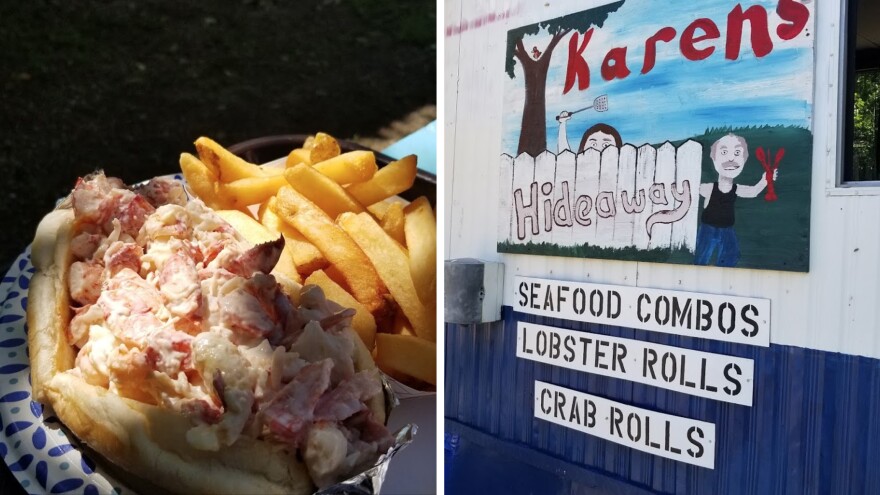If you're looking for a lobster roll this spring, get ready to dig deep. The pandemic's lasting effects on seafood markets — combined with the sometimes unpredictable ebb and flow of lobster harvests — is driving the price of the New England classic to remarkable highs.
In Maine this month, roadside lobster rolls were going for as much as $34 each.
"This year's just been a crazy year," said Gary Blackman Sr., who with his wife has been running Karen's Hideaway, a low-key but popular lobster shack in coastal Boothbay, for two decades.
As the 2021 tourist season gets underway, he's found himself charging his highest prices ever for a lobster roll: $28 last week. That reflects the high prices resellers like Blackman are paying lobstermen at the dock — when there's product coming in at all.
"The price is way up but the boys aren't catching anything," he said. "That's the kind of year it's been. Why? No one has any answers. I mean, it just could be the water's too cold, the weather's crazy. No one really has an answer."
Lobster landings don't usually get a full head of steam until after Memorial Day, when more boats are in the water and the animals get more active, molting and shedding their old shells. Industry experts say this spring's dizzying prices are driven not just by a relatively low catch, but also by consumer habits that were transformed during the pandemic.
Annie Tselikis, executive director of the Maine Lobsters Dealers Association, says when lockdowns shuttered much of the restaurant, casino and cruise ship industries last year, seafood sales plummeted. But as the pandemic wore on, home chefs pulled out their cookbooks — or their online cooking apps — and started to experiment.
"And so people were buying not only lobster but other seafood products from their supermarkets or their local fishmongers or directly from fishermen and they were trying things," Tselikis said.
Dealers ultimately matched that market trend, she said, by repackaging and redirecting inventory that originally was destined for the food-service industry. Retail seafood sales hit record levels.
U.S. retail prices for seafood rose 19% in a 13-week period that ended just last month compared to the same period last year — the biggest price jump of any retail commodity.
Now, with the big seafood outlets like restaurants and casinos opening back up, and tourists venturing forth, some wholesalers are stretched to serve both a reviving food-service industry and roaring retail markets at the same time.
"We are seeing really high demand for lobster, for seafood," Tselikis said. "And that's true not only here in Maine, but throughout the country."
In the midst of the pandemic, sellers also worked to get consumers more comfortable with items that were once rarely seen in home refrigerators, such as live oysters or mussels.
Oysters are notoriously a hard sell for home consumption, because their shells can be challenging to open. And when the restaurant markets crashed, some shellfish growers were forced to leave inventory in the water. That can go on for only so long, though, because they will eventually grow to a size consumers reject as just too much of a mouthful.
Oyster evangelists such as Rifko Meier, a New York-based caterer with national scope, are appearing in DIY oyster-shucking videos to help the cause. A Chesapeake Bay media group recorded him demonstrating his shucking chops — with mask in place — in a December Youtube video.
"You turn the knife like a key in a lock, left and right. You turn left, you turn right," he tells viewers.
Oyster bars are opening for the summer season and prices have stabilized but have not yet seen outsized increases like some other seafoods.
For everyone in the industry, balancing demand, price, costs and inventory is a constant challenge. Back at Karen's Hideaway in Boothbay, Maine, Gary Blackman Sr. said this season's high lobster prices have hurt his revenues.
But he's not all that worried about whether the summer haul will come in.
"I know in a couple weeks ... they'll be coming out my nose, and I know it," he said. "And then I'll be growling because there's too many."
And lobstermen say they are beginning to find more active lobsters in their traps. That's the springtime signal that bigger harvests, and possibly more tourist-friendly prices, are on their way.
Copyright 2021 Maine Public




